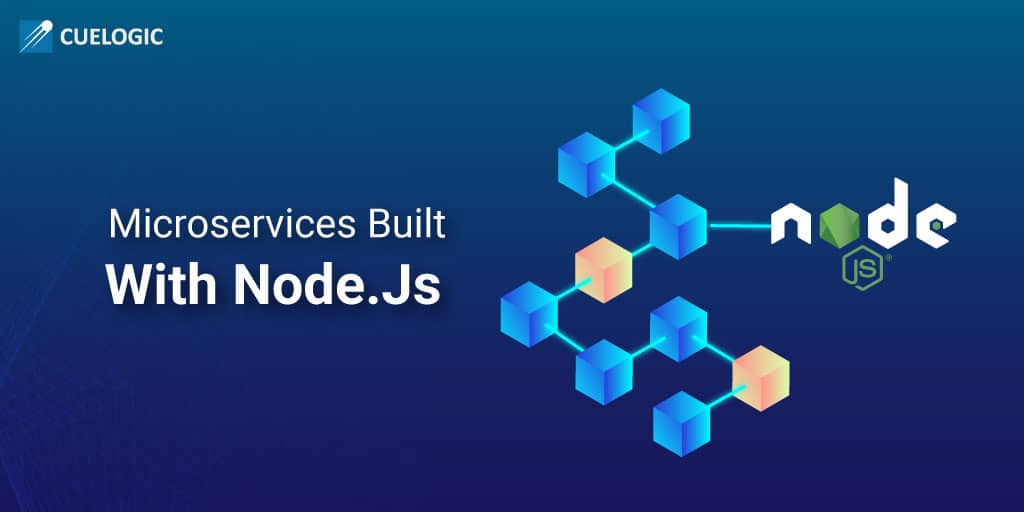——————————————————————————————————————————-
In today’s software development industry, microservices have been recognized as the most preferred architecture style. This robust and scalable architecture reduces development challenges while building complex applications. Moreover, Node.js ensures streamlined microservice development due to its efficiency, event-driven nature, and active ecosystem. The combination of Node.js and microservices can help businesses like yours create real-time applications that meet today’s dynamic demand.
What is Microservices Architecture?
Microservices architecture is a modular approach revolutionizing application development. This architecture splits complex applications into smaller and manageable services. Each service operates independently yet works together seamlessly, unlike traditional monolithic architectures, where every component is intertwined.
Some of the benefits of microservices architecture include:
- Simplifies updates and enhances application stability.
- Promotes flexibility and makes it easier to adapt and scale applications.
Node.js supports microservices with its lightweight, scalable nature. It’s ideal for building individual microservices that perform specific functions efficiently. It’s ideal for building individual microservices that perform specific functions efficiently.
Advantages of using Node.js for Microservice Development
Node.js is renowned for its event-driven and non-blocking I/O model. This made it a popular option for microservices development. Some of the advantages that make Node.js an ideal option for microservice development are:
- Scalability: Node.js stands out for its ability to handle numerous simultaneous connections with ease. Its lightweight nature simplifies scaling services to meet your growing business needs, making it an excellent choice for enterprise application development.
- Optimized performance: Node.js offers a non-blocking I/O model. This model ensures that your microservices run efficiently and handle many connections smoothly. This results in quicker response times and a smoother user experience.
- Rich ecosystem: You can access countless packages and modules through the NPM (Node Package Manager) registry. This rich ecosystem allows for rapid development and deployment of services. You may hire Node.js developers to select and implement the right packages in your project efficiently. These professionals can effectively handle and implement multiple packages to deliver optimal results.
- Improved productivity: Node.js’s modular nature aligns perfectly with microservices, allowing teams to work independently and parallelly. This results in quicker iterations, faster delivery of features, and a more efficient development cycle.
- Strong community support: Node.js has an active community of developers that offers knowledge, extensive documentation, and shared modules. This community-driven support accelerates problem-solving and innovation in your microservices development.
Structure of Microservices
Microservices comprise three essential elements – Components, Communication protocols, and Data management. These elements, each with a specific role, work together harmoniously for optimized performance.
- Components: Each component in microservices performs a specific function, contributing to the overall application. From request handling to processing operations, components ensure smooth and efficient service execution.
- Communication protocols: Communication protocols ensure seamless interactions and data exchange in microservices. Protocols like HTTP/REST for web requests and messaging systems like RabbitMQ for event-driven communication are crucial in maintaining the flow and coordination among services.
- Data management: Data management promotes resilience and scalability. Each microservice handles its data and ensures independence and stability.
5 Popular Frameworks to Consider for Your Node.js Microservice
Here is a list of the most popular frameworks that you can consider for your Node.js microservice project:
- Express.js: Known for simplicity and minimalism, Express.js is a go-to framework for Node.js microservices. It offers flexibility, rapid development, and a robust routing API.
- Feathers: Feathers specializes in real-time applications and REST APIs. It’s a lightweight wrapper that provides an instant setup for microservices.
- Hapi.js: Hapi.js stands out for its powerful plugin system. It offers a solid foundation for building complex applications, ensuring security and scalability.
- LoopBack: LoopBack is ideal for building dynamic end-to-end REST APIs. It offers a rich model-driven approach, simplifying data integration in Node.js microservices.
- Nest.js: Nest.js brings TypeScript support and a modular architecture. It’s designed for building efficient, reliable, and scalable server-side applications.
Furthermore, there are many other Node.js frameworks available. While selecting one, you must ensure that a framework matches your project requirements for the best results.
How to Develop Your Microservices with Node.js?
In this section, we will guide you through the process of constructing microservices using Node.js in detail, from conceptualization to execution.
Step 1: Define Business Requirements
Initiate by comprehensively understanding the requirements. It’s crucial to align your technical solutions with business goals. For instance, if your project involves calculating distances between ZIP codes, consider how best to integrate external APIs for performance optimization and cost-effectiveness.
Step 2: Initialization
- Installation and setup: Install Node.js to lay the groundwork for your microservice project. This sets the stage for your project.
- Dependency management: Utilize NPM to manage your project’s dependencies efficiently. It’s a cornerstone for maintaining a clean and manageable codebase.
- Project initiation: Execute ‘$ npm init’ to initiate your project, followed by installing critical packages like Express.js and Request. These form the backbone for handling API interactions in your microservices.
Step 3: Server Setup
- Creating the core of the application: The “server.js file” is the core of your application. It’s where you define how your server behaves and responds to requests.
- Routing and responsiveness: Establish routes to handle requests efficiently. A well-defined routing mechanism ensures that your service is responsive and reliable.
Step 4: Route Analysis
Analyze and define clear routes in your application. This ensures that every request is directed to the appropriate service endpoint. For example, configuring routes like ‘/about’ and ‘/distance/:zipcode1/:zipcode2’ helps handle specific requests. It’s a step towards creating a user-centric and service-oriented architecture.
Step 5: Controller Logic
- Flow management: Develop the logic to control the flow of data and requests within your microservices. This logic acts as the decision-maker, ensuring that every component interacts harmoniously.
- Function implementation: Implement key functions such as ‘about’ and ‘get_distance’. Ensure these functions are robust and can handle the dynamic nature of service requests.
Step 6: External API Integration
- Enhancing functionality: Integrate external APIs to augment the capabilities of your microservices. This step is about expanding your service’s functionality beyond its core.
- Robust interaction: Focus on creating a robust mechanism for API calls. This includes error handling, response validation, and ensuring the integrity of the data exchanged.
Step 7: Execution and Testing
- Launching services: After meticulous development, it’s time to launch your microservices. Ensure every component is optimized and ready for action.
- Thorough testing: Emphasize rigorous testing. Confirm that your microservices not only meet the technical specifications but also align with business objectives. It’s a critical step in advanced Node.js development.
Challenges in Node.js Microservices and Strategies to Overcome Them
During Node.js microservices, you may encounter the following challenges. However, with the right strategies, you can overcome them and ensure efficient microservice development.
- Performance bottlenecks: Recognize areas where your microservices may slow down or become less responsive. Bottlenecks can arise from inefficient code, high latency in communication, or overloaded servers. You can implement caching, optimize database interactions, ensure efficient load balancing, and monitor performance metrics to identify and address bottlenecks promptly.
- Error handling: In a distributed system, errors need to be managed gracefully to prevent service failures. Therefore, you must develop comprehensive error-handling mechanisms and ensure each microservice can independently manage errors. This will prevent them from affecting other services.
- Interservice communication complexities: Acknowledge the complexities in communication between different microservices. Issues can stem from network latency, message formatting, or data consistency. To prevent these issues from arising, you must standardize communication protocols and data formats. You may employ API gateways or message brokers to manage and route communication effectively between services.
Conclusion
The adoption of microservices combined with the power of Node.js marks a significant evolution in the software development industry. Microservices architecture offers unparalleled flexibility, scalability, and resilience, enabling businesses to overcome the complexities and meet the demands of modern digital efficiently. Meanwhile, Node.js enhances this architectural paradigm with its non-blocking, event-driven nature, facilitating seamless service interactions and robust performance. Together, they forge a formidable duo that accelerates development cycles and ensures that applications remain responsive and adaptable to future technological advancements.















